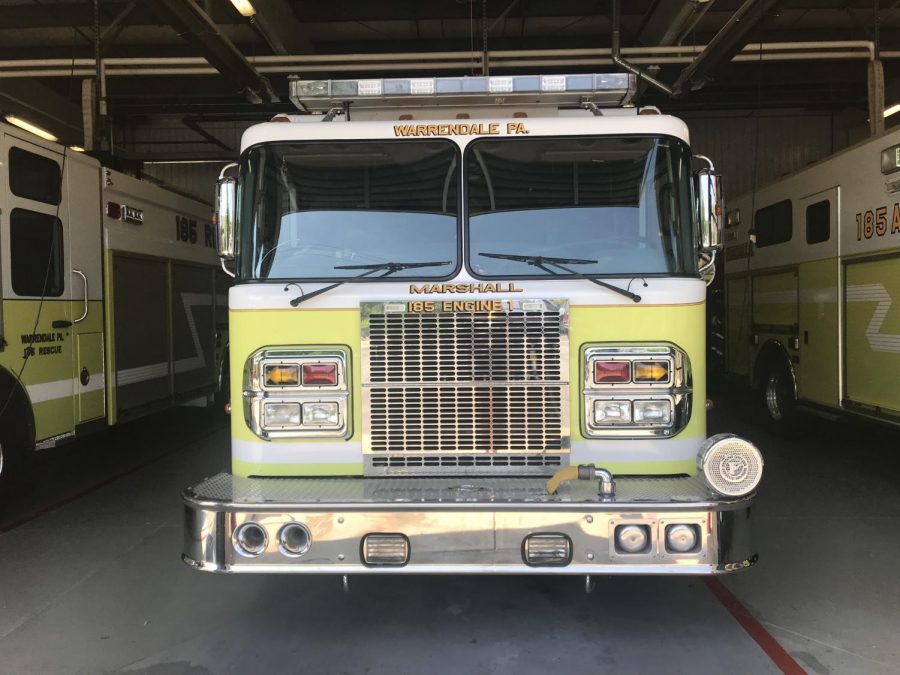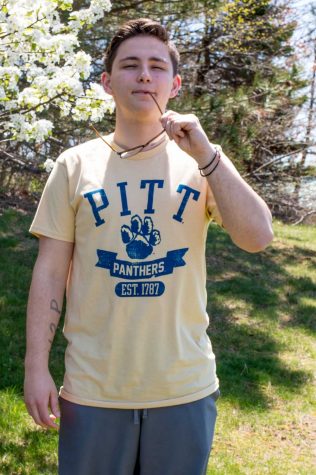Lights and Sirens
Behind the scenes in the life a student volunteer firefighter
May 22, 2018
On the Thursday before prom, NASH hosted a Mock Crash to raise awareness on the seriousness of drinking and driving by simulating a car crash. During the mock crash, firefighters set up a landing zone, extricated victims, and assisted EMS and the Coroner Service. If you felt like you could see yourself helping in an accident scene as a first responder, you can do so in real life as a volunteer firefighter.
In the case of most Fire Departments, anyone ages 16 and up can join a local department and volunteer. Each new probationary member will have to complete 180+ hours of basic training, combined with extensive continued training. Volunteer firefighters also can involve themselves in the administrative side of the Fire Department. But most importantly, volunteer firefighters respond to emergencies.
The Marshall Township Volunteer Fire Department — the fire department that I am a member of — responds to over 400 calls a year. Each time someone calls 911 for an emergency where the department is needed, the county dispatch sends an alert to our phones and pagers. We then will drive over to the station, hop into our trucks, and rush to the emergency. We are a group of dedicated members who respond daily to help people in the lowest of times. Being a volunteer firefighter is a very challenging but profound experience, and there are many emergency calls that I have been on that have both been very rewarding and very saddening for me. The next few stories will provide a small piece of insight into the life of a volunteer firefighter.
My first call with the Marshall Township Volunteer Fire Department was a very fast-paced welcome to the department. A police officer had pulled over a teenager for speeding through a neighborhood. The boy’s car caught on fire, and the car’s brake malfunctioned. This caused the car to start rolling down the hill where it was stopped. The car then luckily hit the police car and started to swerve to the side. If the car had not hit the police cruiser, it would have ran into a house while on fire. To add to the absurdity of the call, the car was filled to the brim with some gasoline that the teen had just recently bought in order to go dirt biking. We quickly showed up on scene and were met with a fully involved car fire. On top of that, the fire was starting to spread to a nearby house. We quickly put out the house fire and then moved onto the car itself. Flames were shooting out everywhere, and it took half an hour to suppress the fire. Although I did not play a major role in putting out this car fire, I have helped put out many other car fires throughout my career.
I have also had my fair share of house fires. One January night, we were called to assist the Wexford Volunteer Fire Department for a reported fire. As we were responding, the chiefs had arrived on scene and reported that there was fire showing from the basement. As we were responding on Perry Highway with lights and sirens blaring, I rolled down my window and a wave of smoke hit me. We were still a mile away, and I could smell the fire. My friend and I looked at each other, and we both knew, this was a big one.
Once our truck arrived on scene, we were hit with a fully involved fire with flames shooting out of the basement. During the first three and a half hours of the fire, I was assisting firefighters by refilling their air packs and giving them water while they were resting after fighting the fire from the inside. For the last four and a half hours, I was assigned to an exterior firefighting team. We went to the right side of the house and started to knock down the fire on the porch and the first floor. I took a thermal imaging camera, found some patches of fire, and used a pikes pole to knock down the wall in which the fire was in. Since the floor was collapsed where we were fighting the fire, I had to hang out of the windowsill to break down the wall, while another firefighter used a hose to put the fire itself out. Then, I went to the back of the house to find another patch of fire. We used thermal imaging cameras to find the final patches and doused them with water. Steam and smoke was flying out at us, and the ice that was forming on my face from the cold instantly melted. The ice quickly froze back onto my face as I went back to the front of the house. The roof had collapsed as fire spread to the attic, so we had to put two large diameter hose lines on the roof. As we were spraying the roof with the hose lines, water was spraying down on me. Icicles started to form on my helmet, my glasses started to freeze onto my face, and my eyes started to freeze shut. It became hard to blink, and I became very tired. After eight grueling hours, the fire was finally put out and I was finally able to sleep. I went back to the station, packed up my frozen bunker gear, and went to sleep at 7AM. I woke up at 9AM to respond to another fire. Thankfully, this fire was a lot smaller, so we left the scene an hour later. I immediately fell back asleep and luckily spent the rest of the day call-free.
Although I have been to over 150 emergency calls, one stands out and for all the wrong reasons. One Saturday afternoon, my pager went off for a mutual aid request for a two car accident on the turnpike. As I jumped into the fire truck, the radio traffic seemed to overflow the truck. Firefighters were calling for extrication tools and setting up landing zones for a helicopter. Once we heard this, the driver of our truck pushed down the gas pedal and zoomed through the streets. When we got on the turnpike, we had to push through bumper to bumper traffic. It looked like we were splitting the red sea with our lights and sirens.
When we showed up on scene, we brought extrication tools to the two cars that had collided head on. One car was driving on the wrong side of the road and hit another car head on. Both cars were going 70-80 miles per hour. My friend and I set everything up, and we got ready to hand over the tools to other firemen so we could start putting oil dry on the ground by the cars. That’s when I looked up into the car and saw a body hanging from the seatbelt. I could immediately tell that he had died, and I knew that there was nothing I could do. I remember feeling like I had screwed up somehow. Maybe I did not respond to the station or bring the equipment fast enough. I know now, though, that we all did everything in our power to save the people. Some people just die, and you can’t do anything about it.
Afterwards, the officer on scene kicked us out to the back of the accident scene. We stood around for a bit while the police and coroners did their investigation, and then I watched as the coroners wheel back two bodies covered in velvet covering identical to the ones at NASH’s mock crash. I remember that I had to distract some bystanders so that they wouldn’t focus on the bodies. Then I watched over the coroner’s van while the coroner was finishing up his report. I stayed right outside the van to make sure no one tried to do anything with the bodies. And then, five hours later, we went home and I resumed my normal life.
This experience and many other similar calls that I have been on have taught me to appreciate life, because it can end all too abruptly. One second you could be driving on the turnpike, and the next second a driver on the wrong side of the road hits you and you die. You don’t have any control over when and where you will die, so it is important to enjoy your life.
But not every call is as crazy as these past few calls I described. Most of the calls I go on are minor car accidents or fire alarms. I also have helped save a lot of people and a lot of property. It is very rewarding to know that we made someone’s day a bit better in the worst of times.
The Fire Department is always looking for new people to join. It is very hard to respond effectively to the growing number of calls when the number of members is going down. Of course, not every call will be an exhilarating experience, but overall the opportunity to serve the community as a volunteer fire fighter is unique, rewarding, and highly recommended.












